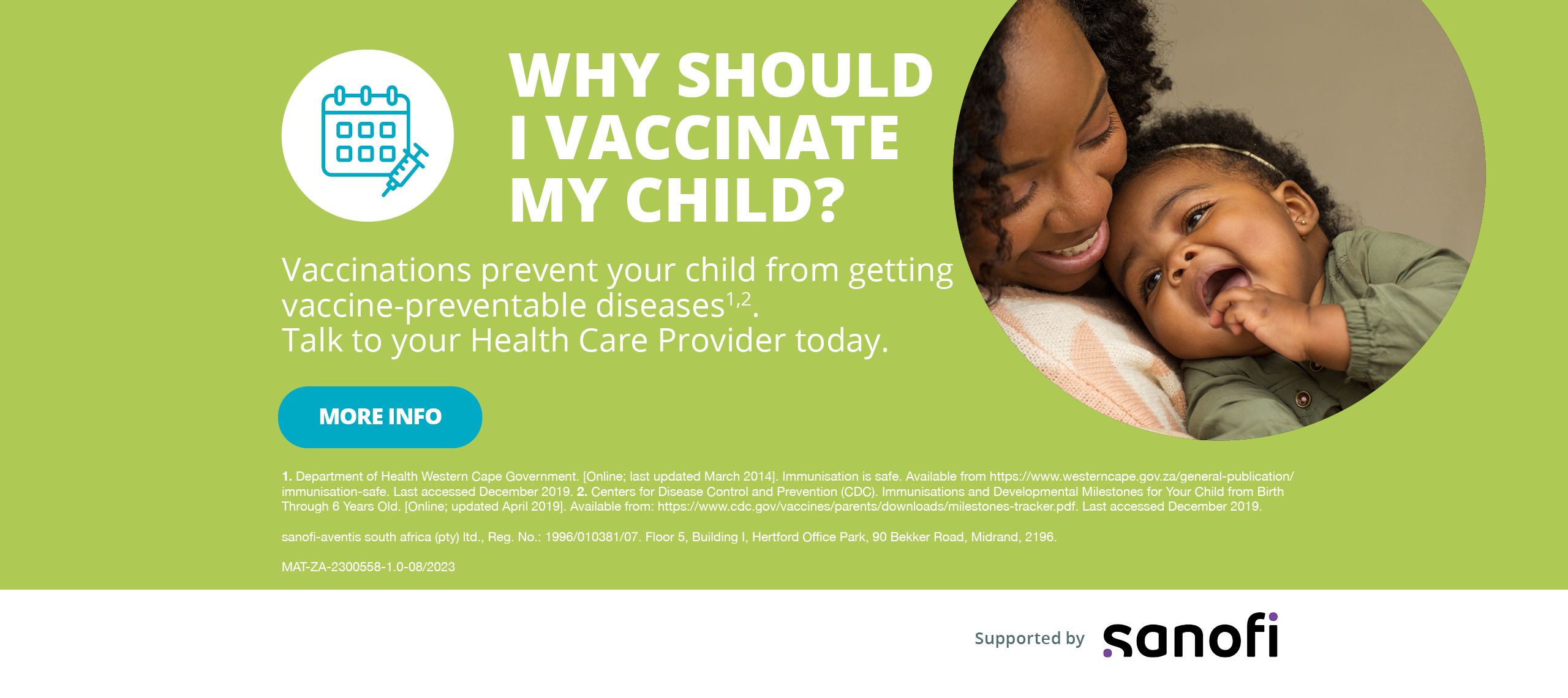Why routine vaccinations are so important
The vaccination journey for your child starts when you are pregnant and continues after your child's birth1,2. This journey can be overwhelming to the first-time parent, but there’s nothing to worry about. Keeping up to date with scheduled routine vaccinations may help you (mother) and your growing child develop essential immunity against serious life-threatening diseases1-3.

Vaccinating during your pregnancy and vaccinating your child as they develop through their milestones can seem intimidating to the first-time parent. Keeping up to date with scheduled routine vaccinations may help you and your child develop essential immunity against serious life-threatening diseases1-3.
Once your child is of school-going age, it is important to check that their vaccination status is up to date2, as infectious diseases are common in schools and other childcare settings4.
By adhering to the local routine vaccination schedule, you (mother) and your child may be protected from some serious diseases*, namely5:
*The diseases described below are specific to the vaccines listed in the South African Department of Health Expanded Programme on Immunisation (EPI-SA) Revised Vaccination Schedule from January 20245.
Tuberculosis:
Tuberculosis (TB), a disease caused by the bacterium Mycobacterium tuberculosis, is common in South Africa2. The lungs are the most frequently affected part of the body, although TB can also impact the brain, bones and other organs2. After being infected with the bacteria, young children have a higher chance of developing TB, which may lead to a severe complication known as Tuberculous meningitis (TBM). TBM occurs when the bacteria infect the brain and spinal cord6.
Poliomyelitis:
Poliomyelitis is a highly infectious disease caused by poliovirus7. Poliomyelitis mainly affects infants and children under 5 years of age7. Poliovirus is transmitted through the consumption of food or water contaminated with faeces that contain the virus2. After the virus enters the body of a healthy individual, the infection can be asymptomatic or can cause fever, fatigue, headache, vomiting, stiffness in the neck and painful limbs2. In certain cases, the virus attacks the nervous system, causing sudden weakness or paralysis of the limbs2. The muscles responsible for breathing can also be affected, which can lead to death2.
Hepatitis B:
Hepatitis B is a liver infection caused by the hepatitis B virus8. It is spread when infected blood, semen, or other bodily fluids enter the body8. People can also become infected from birth (mother-to-child), sex with an infected partner, sharing needles, toothbrushes, razors, or via the blood or open sores of an infected person8. Hepatitis B is not spread by sharing eating utensils, breastfeeding, kissing, coughing, or sneezing8. The disease causes inflammation of the liver, affecting its function8. The disease may progress to what is known as chronic hepatitis B, which is a lifelong illness causing cirrhosis (liver scarring affecting function), liver cancer, or even death2,8.
Rotavirus:
Rotavirus is the leading cause of severe diarrhoea in children under 5 years, worldwide9. This diarrhoea can be mild, or it can be serious, accompanied by fever and vomiting, leading to severe dehydration2. The virus is transmitted when faecal matter from a patient is ingested by a healthy individual through unclean hands, contaminated objects, food, or water2.
Haemophilus influenzae type b:
Haemophilus influenza type b (Hib) can cause serious illness and death in babies and children younger than 5 years old2. The infection can spread when an infected person coughs or sneezes, sending tiny drops from their breath into the air and someone else breathes those drops in2. Different parts of the body can be infected by the bacteria – including the face, joints, bones, lungs, brain, heart and abdomen2. The consequences of this infection can lead to permanent hearing problems, and in severe cases, death2.
Tetanus:
Tetanus is caused by the bacterium Clostridium tetani, which releases a toxin after it enters a wound through exposure to contaminated dirt and animal faeces2,10. This toxin leads to painful muscle contractions or spasms. A common symptom is the inability to open the mouth, due to spasms in the facial muscles, which is why it's called “locked jaw”2. Tetanus may cause complications such as breathing problems, pneumonia, blood clots in the blood vessels of the lungs (pulmonary embolism), broken bones and even death10.
Diphtheria:
Diphtheria is spread by person-to-person contact, usually through respiratory droplets which may occur during coughing or sneezing2. Left untreated, it can cause breathing problems, nerve damage and heart damage11. For some, it can be fatal2.
Whooping cough (Pertussis):
Whooping cough is caused by a type of bacteria called Bordetella pertussis2. It is transmitted when an infected person sneezes or coughs nearby and the tiny germ-laden droplets are inhaled2,12. In teens and adults, complications of strenuous coughing may arise in the form of bruised or cracked ribs, abdominal hernias, or even broken blood vessels in the skin or the whites of the eyes. In babies, complications may include pneumonia, slowed or stopped breathing, dehydration, seizures, or brain damage12.
Pneumococcal disease:
Pneumococcal disease is caused by the bacterium Streptococcus pneumoniae, which infects the respiratory tract, but can lead to severe infections of the blood, ears, or brain2. In South Africa, it is one of the leading causes of ear infections (otitis media) and meningitis2. The disease is transmitted through tiny droplets from secretions of the nose and throat of infected persons2.
Measles:
Measles is one of the world’s most contagious diseases, spread by contact with infected nasal or throat secretions (coughing or sneezing) or breathing the air that was breathed by someone with measles13. Measles usually shows up as a high fever with flu-like symptoms (cough, sore throat, nasal congestion and conjunctivitis). In some cases, it may cause white spots on the inner cheeks of the mouth. This is followed by a rash on the face, which spreads to the rest of the body and usually lasts around a week2. The complications of measles may include diarrhoea, dehydration, brain infection, blindness and death2.
Rubella (German measles):
Rubella, also known as German measles, is a contagious illness caused by the rubella virus14. The symptoms of rubella include fever and a rash14. The illness is usually mild in children and adults, but can be very harmful if contracted by pregnant women14. Rubella can infect the unborn baby and lead to a condition called Congenital Rubella Syndrome (CRS). The serious consequences of CRS include heart conditions, hearing problems and developmental delays14.
Human papillomavirus:
Human papillomavirus (HPV) infections are transmitted either sexually, or through other skin-to-skin contact15. There are more than 100 varieties of HPV15. Some types of HPV infection cause warts, and some can cause different types of cancer15. Genital HPV can cause cancer of the lower part of the uterus that connects to the vagina (cervix), as well as other types of cancers, involving the anus, penis, vagina, vulva and back of the throat15.
Some of the vaccines listed in the EPI-SA routine immunisation schedule require more than one dose or booster dose5.


Why is more than one vaccination dose required?
Vaccines work by teaching our bodies to recognise specific dangerous pathogens (disease-causing organisms), so that our immune system is prepared to ‘fight off’ that infection in the future16. Depending on the pathogen, the type of vaccine used, and how our body’s immune system responds, vaccine protection can ‘wear off’ with increasing age, or over time17. More than one dose of a vaccine, or booster doses may be required, to maintain optimal protection against the pathogen16.
Routine vaccinations and booster doses are timed through different age and life stages – laid out in a way that helps your body, as well as that of your child’s, develop adequate immunity to certain potentially life-threatening diseases2,5.
To help you track your (mother) and your child’s vaccination schedule, visit here
Read more how to prevent and protect with Sanofi:
References:
- Centers for Disease Control and Prevention (CDC). Pregnancy and Vaccines. Available from: https://www.cdc.gov/vaccines/parents/by-age/pregnancy.html. Accessed April 2024.
- National Institute Communicable Diseases (NICD). Vaccine Information for Parents and Caregivers. Available from: https://www.nicd.ac.za/wpcontent/uploads/2017/08/NICD_Vaccine_Booklet_D132_FINAL.pdf. Accessed April 2024.
- National Department of Health (NDoH), Republic of South Africa. Tetanus, reduced-strength diphtheria, and acellular pertussis (Tdap). Knowledge Hub Webinar. October 2023. Available from: https://knowledgehub.health.gov.za/system/files/2023-11/KH%20webinar%20Session%202%20Tdap%20-%20final.pdf. Accessed April 2024.
- Czumbel I, Quinten C, et al. Management and control of communicable diseases in schools and other childcare settings: systematic review on the incubation period and period of infectiousness. BMC Infectious Diseases. 2018 18:199.
- Department of Health (DoH), South Africa. Expanded Programme on Immunisation – EPI (SA) Revised Immunisation schedule from January 2024.
- Seddon JA, Tugume L, Solomons R, et al. Tuberculous Meningitis International Research Consortium. The current global situation for tuberculous meningitis: epidemiology, diagnostics, treatment and outcomes. Wellcome Open Res. 2019. 5;4:167.
- National Institute for Communicable Diseases (NICD). Poliomyelitis. Frequently Asked Questions. Available from: https://www.nicd.ac.za/wp-content/uploads/2022/02/Poliomyelitis-FAQ_20220218_Final.pdf. Accessed April 2024.
- CDC. Viral Hepatitis. Frequently Asked Questions for the public. Available from: https://www.cdc.gov/hepatitis/hbv/bfaq.htm. Accessed April 2024.
- National Institute for Communicable Diseases (NICD). Rotavirus. Frequently Asked Questions. Available from: https://www.nicd.ac.za/wp-content/uploads/2023/12/RotaFAQ_Nov-2023.pdf. Accessed April 2024.
- Mayo Clinic. Tetanus. Overview. Available from: https://www.mayoclinic.org/diseases-conditions/tetanus/symptoms-causes/syc-20351625. Accessed April 2024.
- Mayo Clinic. Diphtheria. Overview. Available from: https://www.mayoclinic.org/diseases-conditions/diphtheria/symptoms-causes/syc-20351897#Complications. Accessed April 2024.
- Mayo Clinic. Whooping cough - Symptoms and causes. Available from: https://www.mayoclinic.org/diseases-conditions/whooping-cough/symptoms-causes/syc-20378973.pdf Accessed April 2024.
- National Institute for Communicable Diseases (NICD). Measles. Frequently Asked Questions. Available from: https://www.nicd.ac.za/wp-content/uploads/2022/06/Document_FAQ_measles_20220603.pdf. Accessed April 2024.
- National Institute for Communicable Diseases (NICD). Rubella. Frequently Asked Questions. Available from: https://www.nicd.ac.za/wp-content/uploads/2023/10/Rubella-FAQpublic_20231019_final.pdf. Accessed April 2024.
- Mayo Clinic. HPV Infection. Overview. Available from: https://www.mayoclinic.org/diseases-conditions/hpv-infection/symptoms-causes/syc-20351596. Accessed April 2024.
- World Health Organization (WHO). Europe. How Vaccines Work. Infographic. Available from: https://www.who.int/europe/multi-media/item/how-vaccines-work-(2018). Accessed April 2024.
- UChicago Medicine. How do vaccines work? Available from: https://www.uchicagomedicine.org/forefront/coronavirus-disease-covid-19/demystifying-vaccines-1. Accessed April 2024.
sanofi-aventis south africa (pty) ltd., Reg. No.: 1996/010381/07, Floor 5, Building I, Hertford Office Park, 90 Bekker Road, Midrand, 2196.
MAT-ZA-2301100-1.0 - 04/2024


